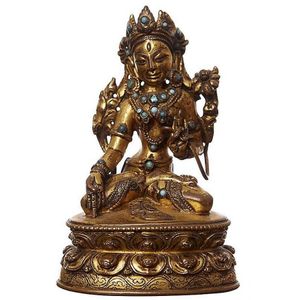Qing Dynasty Bronze Figure of Vairocana Buddha
You must be a subscriber, and be logged in to view price and dealer details.
Subscribe Now to view actual auction price for this item
When you subscribe, you have the option of setting the currency in which to display prices to $Au, $US, $NZ or Stg.
- Foliate - Decorated with leaves or leaf-like forms.
- Tier - One or more under-shelves of a table or cabinet.
- Bronze - An alloy of copper and tin, traditionally in the proportions of about 9 parts of copper to 1 part of tin.
The discovery of bronze in Western Asia in the 4th century enabled people to create metal objects which were superior to those previoulsy possible because of its strength and hardness, and it has been used throughout the world for weapons, coins, tools, statuary and other decorative items.
It is very fluid in a molten state, and its hardness, strength when set, and non-corrosive properties makes it most suitable for casting sculpture. - Qing Dynasty - The Qing Dynasty was the last imperial dynasty of China, ruling from 1644 to 1912. It was established by the Manchu people, who originated from the northeastern region of China. The Qing Dynasty was preceded by the Ming Dynasty and followed by the Republic of China.
- Ming Dynasty - The Ming Dynasty was a ruling dynasty of China from 1368 to 1644. It succeeded the Yuan Dynasty and preceded the Qing Dynasty. The Ming Dynasty was established by Zhu Yuanzhang, a former Buddhist monk who became a rebel leader and eventually overthrew the Mongol Yuan Dynasty. During the Ming Dynasty, China experienced a period of relative stability and prosperity. The government was centralized and bureaucratic, with the emperor at the top of the hierarchy. The Ming Dynasty is known for its cultural achievements, including the development of porcelain, the invention of movable type printing, and the construction of the Great Wall of China.
This item has been included into following indexes:
-
Oriental deities, bronze
- Buddha 653
- Tibetan deities 129
- oriental deities, bronze - Vairocana 2
- Oriental deities, Tibetan and Sino-Tibetan - Buddha and other deities 265
- oriental jewellery - necklaces 426
Visually similar items

A large Tibetan gilded bronze figure of Tara, modelled with a serene downcast gaze, seated on a double lotus base, hands in the dharmachakra mudra, 49 cm high

A gilt bronze Manjushri statue Manjushri seated on a lotus pedestal, wearing a Crown, eyes cast downward, holding a bell in left hand and a Vajra pestle in the right, 43 cm high

A Tibetan gilt bronze white Tara, 16th century, the fire-gilded bronze with turquoise inlay, the right hand in Bhumispharsha mudra and holding a lotus in the left, seated on a double lotus throne, with sealed base, 10.5 cm high. Provenance: Cito Cessna, Pa

A seated bronze Buddha with fine detailing, Indo-Tibetan, 18th/19th century, ushnisha, a tall top knot, decorated with garlands of beads over the closely plaited hair, the urna, eye of wisdom above a monobrow on a meditative face, height 11 cm
